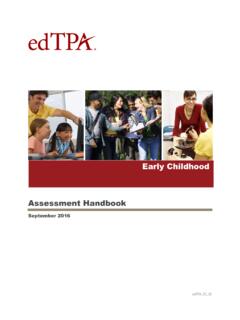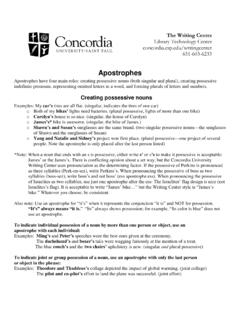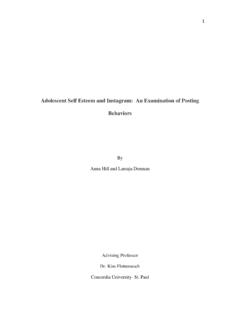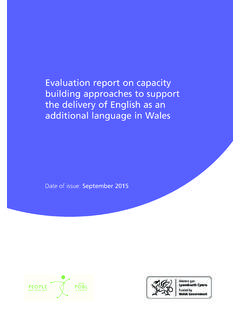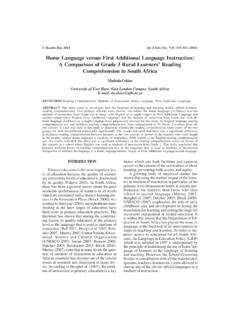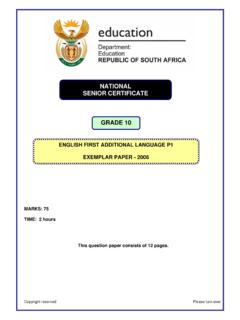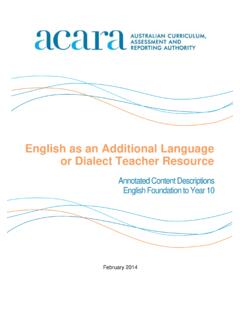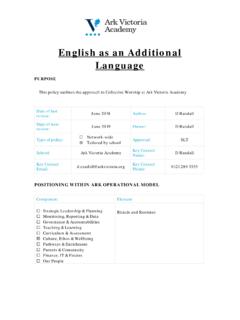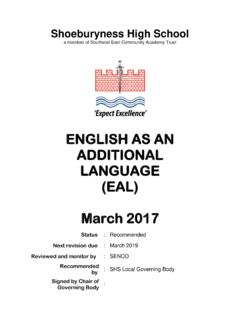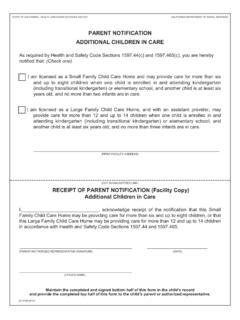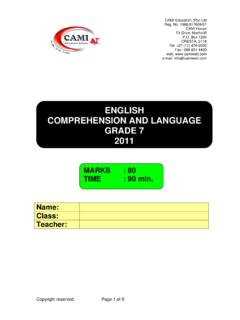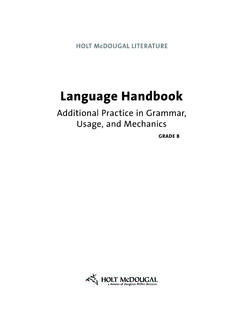Transcription of English as an Additional Language
1 EdTPA_EAL_06 English as an Additional Language Assessment Handbook September 2016 edTPA stems from a twenty-five-year history of developing performance-based assessments of teaching quality and effectiveness. The Teacher Performance Assessment Consortium (Stanford and AACTE) acknowledges the National Board for Professional Teaching Standards, the Interstate Teacher Assessment and Support Consortium, and the Performance Assessment for California Teachers for their pioneering work using discipline-specific portfolio assessments to evaluate teaching quality. This version of the handbook has been developed with thoughtful input from over six hundred teachers and teacher educators representing various national design teams, national subject matter organizations (ACEI, ACTFL, AMLE, CEC, IRA, NAEYC, NAGC, NCSS, NCTE, NCTM, NSTA, SHAPE America), and content validation reviewers. All contributions are recognized and appreciated. This document was authored by the Stanford Center for Assessment, Learning, and Equity (SCALE) with editorial and design assistance from Evaluation Systems.
2 Copyright 2016 Board of Trustees of the Leland Stanford Junior University. All rights reserved. The edTPA trademarks are owned by The Board of Trustees of the Leland Stanford Junior University. Use of the edTPA trademarks is permitted only pursuant to the terms of a written license agreement. edTPA English as an Additional Language Assessment Handbook iCopyright 2016 Board of Trustees of the Leland Stanford Junior University. All rights Introduction to edTPA English as an Additional of the Assessment ..1 Structure of the English as an Additional Language Tasks Task 1: Planning for Instruction and Do I Need to Think About? ..9 What Do I Need to Do?..9 What Do I Need to Write?..11 How Will the Evidence of My Teaching Practice Be Assessed?..14 Planning Task 2: Instructing and Engaging Students in Learning ..20 What Do I Need to Think About? ..20 What Do I Need to Do?..20 What Do I Need to Write?..22 How Will the Evidence of My Teaching Practice Be Assessed?..23 Instruction Rubrics.
3 24 Assessment Task 3: Assessing Student Do I Need to Think About? ..29 What Do I Need to Do?..29 What Do I Need to Write?..30 How Will the Evidence of My Teaching Practice Be Assessed?..33 Assessment Rubrics ..34 Professional Responsibilities ..39 English as an Additional Language Context for Learning as an Additional Language Evidence Chart ..43 Planning Task 1: Artifacts and Commentary Task 2: Artifacts and Commentary Specifications ..45 Assessment Task 3: Artifacts and Commentary Specifications ..46 English as an Additional Language English as an Additional Language Assessment Handbook Copyright 2016 Board of Trustees of the Leland Stanford Junior University. All rights of 53 This document contains both information and definition pop-ups. To read information, use the Down Arrow from a form field. Introduction to edTPA English as an Additional Language11 The term English as an Additional Language (EAL) recognizes that English Language learners (ELLs) might already speak multiple languages in addition to English .
4 Purpose The purpose of edTPA English as an Additional Language , a nationally available performance-based assessment, is to measure novice teachers readiness to teach English as an Additional Language . The assessment is designed with a focus on student learning and principles from research and theory. It is based on findings that successful teachers employ their knowledge of subject matter based on the TESOL P 12 Professional Teaching Standards develop and apply knowledge of varied students needs consider research and theory about how students learn reflect on and analyze evidence of the effects of instruction on student learning As a performance-based assessment, edTPA is designed to engage candidates in demonstrating their understanding of teaching and student learning in authentic ways. Overview of the Assessment The edTPA English as an Additional Language assessment is composed of three tasks: 1. Planning for Instruction and Assessment 2. Instructing and Engaging Students in Learning 3.
5 Assessing Student Learning For this assessment, you will first plan 3 5 consecutive lessons in English as an Additional Language (EAL) (or if teaching within a large time block, about 3 8 hours of connected instruction) referred to as a learning segment. Consistent with the recommendations provided by Teachers of English to Speakers of Other Languages (TESOL) for EAL professionals (2010),2 a learning segment prepared for this assessment should support students English Language proficiency/development (ELPD3) within meaningful content-based instruction. The learning segment should demonstrate your ability to plan for, implement, and assess students English Language development within content-based instruction that is relevant to students content and Language development goals. This includes developing students command of Language functions and Language competencies through two or more of the four modalities (speaking, listening, reading, writing). Language competencies include the following: 2 See the TESOL International Association website at 3 The term ELPD recognizes that states may use the term English Language proficiency (ELP) or English Language development (ELD).
6 EdTPA English as an Additional Language Assessment Handbook 2 of 53 Copyright 2016 Board of Trustees of the Leland Stanford Junior University. All rights competence: the ability to use correct vocabulary and sentence structures Discourse competence: the ability to produce coherent and cohesive written or spoken discourse ( , paragraphs or conversations) that conforms to the norms of different genres ( , letter, essay, interview) Pragmatic competence: the ability to use Language appropriately in communication based on the context and the relationship between the speaker and listener and the writer and reader Metalinguistic competence: knowledge of linguistic/grammatical concepts and functions, and the ability to use linguistic terminology to describe or discuss them Scaffolding, or sheltering, techniques, including home Language , should be used as you demonstrate the ability to provide targeted supports for Language development and to make content accessible to English Language learners (ELLs) within a content-based unit of study, for example, in Language arts, social studies, science.
7 You will then teach the learning segment, making a videorecording of your interactions with students during instruction. You will also assess, informally and formally, students learning throughout the learning segment. Upon completion of the three tasks, you will submit artifacts from the tasks ( , lesson plans, clips from your videorecording, assessment materials, instructional materials, student work samples), as well as commentaries that you have written to explain and reflect on the Planning, Instruction, and Assessment components of the tasks. The artifacts and commentaries for each task will then be evaluated using rubrics especially developed for each task. The edTPA Tasks and the Cycle of Effective Teaching The three edTPA tasks represent a cycle of effective teaching ( , teaching that is focused on student learning). Planning Task 1 documents your intended teaching, Instruction Task 2 documents your enacted teaching, and Assessment Task 3 documents the impact of your teaching on student learning.
8 EdTPA English as an Additional Language Assessment Handbook 3 of 53 Copyright 2016 Board of Trustees of the Leland Stanford Junior University. All rights reserved. The three tasks and the evidence you provide for each are framed by your understandings of your students and their learning. As you develop, document, and teach your lessons, you will reflect upon the cyclical relationship among planning, instruction, and assessment with a focus on your students learning needs. Evidence of Teaching Practice: Artifacts and Commentaries An essential part of edTPA is the evidence you will submit of how you planned, taught, and assessed your lessons to deepen student learning in English as an Additional Language . This evidence includes both artifacts and commentaries: Artifacts represent authentic work completed by you and your students. These include lesson plans, copies of instructional and assessment materials, video clips of your teaching, and student work samples. Commentaries are your opportunity to describe your artifacts, explain the rationale behind their choice, and analyze what you have learned about your teaching practice and your students learning.
9 Note that although your writing ability will not be scored directly, commentaries must be clearly written and well focused. When preparing your artifacts and commentaries, refer to the rubrics frequently to guide your thinking, planning, and writing. Refer to the English as an Additional Language Evidence Chart for information about how your evidence should be formatted for electronic submission. edTPA English as an Additional Language Assessment Handbook 4 of 53 Copyright 2016 Board of Trustees of the Leland Stanford Junior University. All rights Criteria The rubrics used to score your performance are included in the handbook, following the sections describing the directions for each task. The descriptors in the five-level rubrics address a wide range of performance, beginning with the knowledge and skills of a novice not ready to teach (Level 1) and extending to the advanced practices of a highly accomplished beginner (Level 5). Structure of the Handbook The following pages provide specific instructions on how to complete each of the three tasks of the edTPA English as an Additional Language assessment.
10 After an overview of the tasks, the handbook provides instructions for each task organized into four sections: 1. What Do I Need to Think About? This section provides focus questions for you to think about when completing the task. 2. What Do I Need to Do? This section provides specific, detailed directions for completing the task. 3. What Do I Need to Write? This section tells you what you need to write and also provides specific and detailed directions for writing the commentary for the task. 4. How Will the Evidence of My Teaching Practice Be Assessed? This section includes the rubrics that will be used to assess the evidence you provide for the task. Additional requirements and resources are provided for you in this handbook: Professional Responsibilities: guidelines for the development of your evidence English as an Additional Language Context for Learning Information: prompts used to collect information about your school/classroom context English as an Additional Language Evidence Chart: specifications for electronic submission of evidence (artifacts and commentaries), including templates, supported file types, number of files, response length, and other important evidence specifications Glossary: definitions of key terms can be accessed by rolling your cursor over each glossary term marked with a dotted underline throughout the handbook or by referring to the English as an Additional Language Glossary.
